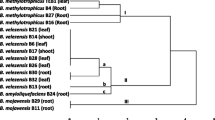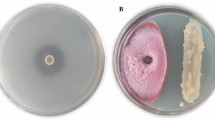Abstract
Antagonistic Bacillus spp. displaying in vitro production of siderophore, chitinase, and β-1,3-glucanase were identified from dual culture assays. In independent greenhouse studies, seed bacterization and soil application of Bacillus atrophaeus S2BC-2 challenge inoculated with Fusarium oxysporum f.sp. lycopersici (FOL) and Alternaria solani (AS) recorded low percent disease index of 25.3 and 28.7, respectively, over nonbacterised pathogen control (44.3 and 56.4). The low disease incidence corroborated with tomato growth promotion with high vigor index (8,041.2) and fresh plant weight (82.5 g) on challenge inoculation with FOL. Analysis of root and leaf samples in rhizobacterial treatment challenged with FOL and AS revealed maximum induction of chitinase (1.9 and 1.7 U/mg of protein, respectively) and β-1,3-glucanase (23.5 and 19.2 U/mg of protein, respectively). In native gel activity assays, the rhizobacterial treatment on challenge inoculation strongly expressed three high intensity PO isoforms along with one low intensity isoform. In studies on genetic diversity of the Bacillus strains by repetitive extragenomic palindromic-polymerase chain reaction (REP-PCR) and amplified rDNA restriction analysis (ARDRA) patterns, ARDRA was more highly discriminant than REP-PCR and allowed grouping of the strains and differentiation of the antagonistic strains from other isolates.



Similar content being viewed by others
Abbreviations
- AS:
-
Alternaria solani
- ARDRA:
-
Amplified rDNA restriction analysis
- FOL:
-
Fusarium oxysporum f.sp. lycopersici
- IMT:
-
Institute of Microbial Technology
- MTCC:
-
Microbial type culture collection
- NTSYS:
-
Numerical Taxonomy System Applied Biostatistics
- PAL:
-
Phenylalanine ammonia-lyase
- PDA:
-
Potato dextrose agar
- PDI:
-
Percent disease index
- VI:
-
Vigor index
- PGPR:
-
Plant growth promoting rhizobacteria
- PO:
-
Peroxidase
- PPO:
-
Polyphenol oxidase
- PRs:
-
Pathogenesis-related proteins
- REP:
-
Repetitive extragenomic palindromic
- UPGMA:
-
Unweighted pair-group method based on arithmetic averages
References
Ajit NS, Rajni V, Shanmugam V (2006) Extracellular chitinases of fluorescent pseudomonads antifungal to Fusarium oxysporum f.sp. dianthi causing carnation wilt. Curr Microbiol 52:310–316
Chen F, Wang M, Zheng Y, Luo J, Yang X, Wang X (2009) Quantitative changes of plant defence enzymes and phytohormone in biocontrol of cucumber Fusarium wilt by Bacillus subtilis B579. World J Microbiol Biotechnol 26:675–684
Chilcott CN, Wigley PJ (1993) Isolation and toxicity of Bacillus thuringiensis from soil and insect habitats in New Zealand. J Invertebr Pathol 61:224–247
Emmert EAB, Handelsman J (1999) Biocontrol of plant disease: a (Gram) positive perspective. FEMS Microbiol Lett 171:1–9
Freitas DB, Reis MP, Lima-Bittencourt CI, Costa PS, Assis PS, Chartone-Souza E, Nascimento AMA (2008) Genotypic and phenotypic diversity of Bacillus spp. isolated from steel plant waste. BMC Res Notes 1:92
Graves LM, Swaminathan B (1993) Universal bacterial DNA isolation procedure. In: Persing DH, Smith TF, Tenover FC, White TJ (eds) Diagnostic molecular microbiology: principles and applications. American Society for Microbiology, Washington DC, pp 617–621
Handelsman J, Stabb EV (1996) Biocontrol of soilborne plant pathogens. Plant Cell 8:1855–1869
Holt JG, Krieg NR, Sneath PHA, Staley JT, Williams ST (1994) Bergey's manual of determinative bacteriology, 9th edn. The Williams and Wilkins Co., Baltimore
Jayaraman KS, Ramanuja MN, Vijayaraghavan PK, Vaidyanathan CS (1987) Studies on the purification of banana polyphenol oxidase. Food Chem 24:203–217
Jetiyanon K, Kloepper JW (2002) Mixtures of plant growth promoting rhizobacteria for induction of systemic resistance against multiple plant diseases. Biocontrol 24:285–291
Kawai A, Kusunoki K, Aiuchi D, Koike M, Tani M, Kuramochi K (2006) Biological control of Verticillium black spot of Japanese radish using Bacillus spp. and genotypic differentiation of selected antifungal Bacillus strains with antibiotic marker. Res Bull Obihiro 27:109–119
Kloepper JW, Ryu CM, Zhang S (2004) Induced systemic resistance and promotion of plant growth by Bacillus spp. Phytopathology 94:1259–1266
Li SM, Hua GG, Liu HX, Guo JH (2008) Analysis of defence enzymes induced by antagonistic bacterium Bacillus subtilis strain AR12 towards Ralstonia solanacearum in tomato. Ann Rev Microbiol 58:573–578
Marten P, Smalla K, Berg G (2000) Genotypic and phenotypic differentiation of an antifungal biocontrol strain belonging to Bacillus subtilis. J Appl Microbiol 89:463–471
Nadlony L, Sequira I (1980) Increase in peroxidase activities are not directly involved in induced resistance in tobacco. Physiol Plant Pathol 16:1–8
Nagorska K, Bikowski M, Obuchowski M (2007) Multicellular behaviour and production of a wide variety of toxic substances support usage of Bacillus subtilis as a powerful biocontrol agent. Acta Biochim Pol 54:495–508
Pan SQ, Ye XS, Kuc J (1991) Association of β-1,3-glucanase activity and isoform pattern with systemic resistance to blue mold in tobacco induced by stem injection with Peronospora tabacina or leaf inoculation with tobacco mosaic virus. Physiol Mol Plant Pathol 39:25–39
Plimmer JR (1993) Regulatory problems associated with natural products and biopesticides. Pestic Sci 39:103–108
Ranjard L, Poly F, Nazaret S (2000) Monitoring complex bacterial communities using culture-independent molecular techniques: application to soil environment. Res Microbiol 151:167–177
Schwyn B, Neilands JB (1987) Universal chemical assay for the detection and determination of siderophores. Anal Biochem 160:47–56
Vakalounakis DJ (1983) Evaluation of tomato cultivars for resistance to Alternaria blight. Ann Appl Biol 102:138–139
Verma R, Naosekpam AS, Kumar S, Prasad R, Shanmugam V (2007) Influence of soil reaction on diversity and antifungal activity of fluorescent pseudomonads in crop rhizospheres. Bioresour Technol 9:1346–1352
Versalovic J, Schneider M, De Bruijn FJ, Lupski JR (1994) Genomic fingerprinting of bacteria using repetitive sequence-based polymerase chain reaction. Methods Mol Cell Biol 5:25–40
Wahyudi AT, Prasojo BJ, Mubarik NR (2010) Diversity of antifungal compounds-producing Bacillus spp. isolated from rhizosphere of soybean plant based on ARDRA and 16S rRNA. HAYATI J Biosci 17:145–150
Xiao L, Xie CC, Cai J, Lin ZJ, Chen YH (2009) Identification and characterization of a chitinase produced Bacillus showing significant antifungal activity. Curr Microbiol 58:528–533
Acknowledgment
The authors are thankful to the Director, Institute of Himalayan Bioresource Technology (IHBT, Palampur, India) and Council of Scientific and Industrial Research, for support and encouragement during the course of this investigation. We also thank Ms. Rajni Verma for extending help in the experiments. This work was supported by the Department of Biotechnology, Government of India (BT/PR 6999/AGR/05/315/2005); IHBT publ. no. 2037.
Author information
Authors and Affiliations
Corresponding author
Rights and permissions
About this article
Cite this article
Shanmugam, V., Atri, K., Gupta, S. et al. Selection and differentiation of Bacillus spp. Antagonistic to Fusarium oxysporum f.sp. lycopersici and Alternaria solani infecting Tomato. Folia Microbiol 56, 170–177 (2011). https://doi.org/10.1007/s12223-011-0031-3
Received:
Accepted:
Published:
Issue Date:
DOI: https://doi.org/10.1007/s12223-011-0031-3




